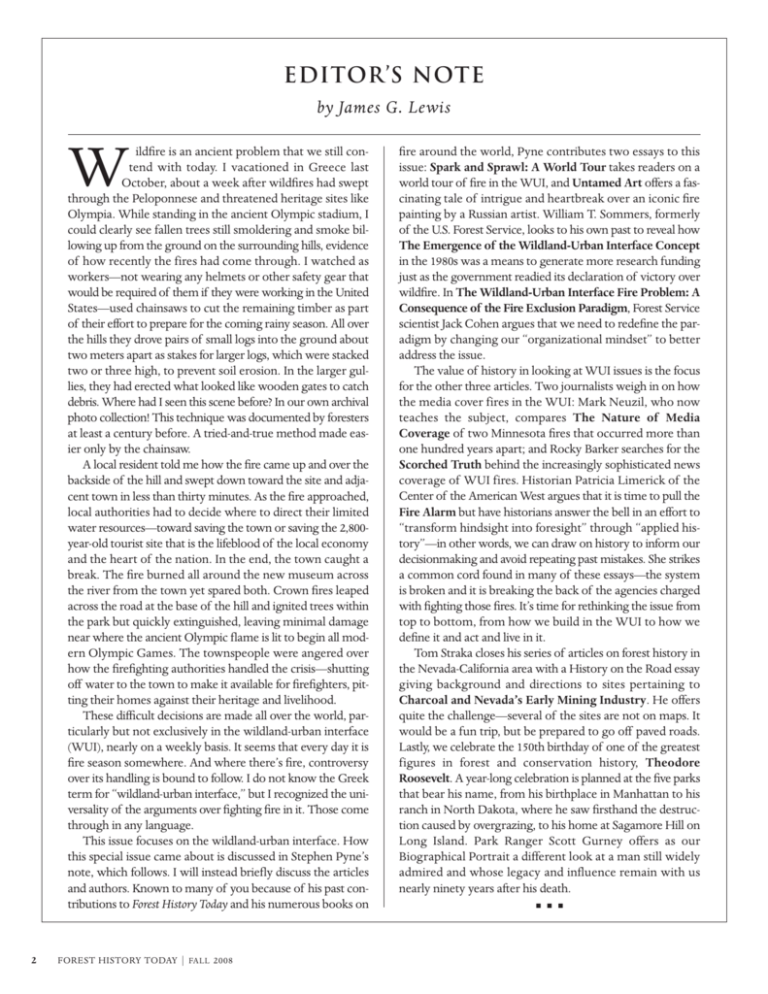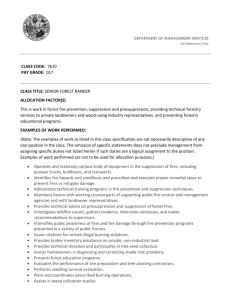Editor's Note - The Forest History Society
advertisement

Editor’s Note by James G. Lewis W ildfire is an ancient problem that we still contend with today. I vacationed in Greece last October, about a week after wildfires had swept through the Peloponnese and threatened heritage sites like Olympia. While standing in the ancient Olympic stadium, I could clearly see fallen trees still smoldering and smoke billowing up from the ground on the surrounding hills, evidence of how recently the fires had come through. I watched as workers—not wearing any helmets or other safety gear that would be required of them if they were working in the United States—used chainsaws to cut the remaining timber as part of their effort to prepare for the coming rainy season. All over the hills they drove pairs of small logs into the ground about two meters apart as stakes for larger logs, which were stacked two or three high, to prevent soil erosion. In the larger gullies, they had erected what looked like wooden gates to catch debris. Where had I seen this scene before? In our own archival photo collection! This technique was documented by foresters at least a century before. A tried-and-true method made easier only by the chainsaw. A local resident told me how the fire came up and over the backside of the hill and swept down toward the site and adjacent town in less than thirty minutes. As the fire approached, local authorities had to decide where to direct their limited water resources—toward saving the town or saving the 2,800year-old tourist site that is the lifeblood of the local economy and the heart of the nation. In the end, the town caught a break. The fire burned all around the new museum across the river from the town yet spared both. Crown fires leaped across the road at the base of the hill and ignited trees within the park but quickly extinguished, leaving minimal damage near where the ancient Olympic flame is lit to begin all modern Olympic Games. The townspeople were angered over how the firefighting authorities handled the crisis—shutting off water to the town to make it available for firefighters, pitting their homes against their heritage and livelihood. These difficult decisions are made all over the world, particularly but not exclusively in the wildland-urban interface (WUI), nearly on a weekly basis. It seems that every day it is fire season somewhere. And where there’s fire, controversy over its handling is bound to follow. I do not know the Greek term for “wildland-urban interface,” but I recognized the universality of the arguments over fighting fire in it. Those come through in any language. This issue focuses on the wildland-urban interface. How this special issue came about is discussed in Stephen Pyne’s note, which follows. I will instead briefly discuss the articles and authors. Known to many of you because of his past contributions to Forest History Today and his numerous books on 2 FOREST HISTORY TODAY | FALL 2008 fire around the world, Pyne contributes two essays to this issue: Spark and Sprawl: A World Tour takes readers on a world tour of fire in the WUI, and Untamed Art offers a fascinating tale of intrigue and heartbreak over an iconic fire painting by a Russian artist. William T. Sommers, formerly of the U.S. Forest Service, looks to his own past to reveal how The Emergence of the Wildland-Urban Interface Concept in the 1980s was a means to generate more research funding just as the government readied its declaration of victory over wildfire. In The Wildland-Urban Interface Fire Problem: A Consequence of the Fire Exclusion Paradigm, Forest Service scientist Jack Cohen argues that we need to redefine the paradigm by changing our “organizational mindset” to better address the issue. The value of history in looking at WUI issues is the focus for the other three articles. Two journalists weigh in on how the media cover fires in the WUI: Mark Neuzil, who now teaches the subject, compares The Nature of Media Coverage of two Minnesota fires that occurred more than one hundred years apart; and Rocky Barker searches for the Scorched Truth behind the increasingly sophisticated news coverage of WUI fires. Historian Patricia Limerick of the Center of the American West argues that it is time to pull the Fire Alarm but have historians answer the bell in an effort to “transform hindsight into foresight” through “applied history”—in other words, we can draw on history to inform our decisionmaking and avoid repeating past mistakes. She strikes a common cord found in many of these essays—the system is broken and it is breaking the back of the agencies charged with fighting those fires. It’s time for rethinking the issue from top to bottom, from how we build in the WUI to how we define it and act and live in it. Tom Straka closes his series of articles on forest history in the Nevada-California area with a History on the Road essay giving background and directions to sites pertaining to Charcoal and Nevada’s Early Mining Industry. He offers quite the challenge—several of the sites are not on maps. It would be a fun trip, but be prepared to go off paved roads. Lastly, we celebrate the 150th birthday of one of the greatest figures in forest and conservation history, Theodore Roosevelt. A year-long celebration is planned at the five parks that bear his name, from his birthplace in Manhattan to his ranch in North Dakota, where he saw firsthand the destruction caused by overgrazing, to his home at Sagamore Hill on Long Island. Park Ranger Scott Gurney offers as our Biographical Portrait a different look at a man still widely admired and whose legacy and influence remain with us nearly ninety years after his death. ■ ■ ■ NO LONGER ON THE FRINGE: THE WILDLAND-URBAN INTERFACE AS HISTORY by Stephen J. Pyne When the American Society for Environmental History decided to hold its annual meeting in Boise in March 2008, it seemed a fitting occasion to bring together two groups—the wildland fire community and that community of historians interested in environmental matters. Here, it seemed, was an ideal opportunity to bring history’s firepower to bear on fire’s own history in a workshop organized by ASEH. Boise is home to the National Interagency Fire Center—the nation’s support center for wildland firefighting—and attendees toured the center as part of the workshop. The intent was to gather different voices than those usually heard within the agencies’ choir. We sought historians of the American West, of urban fire, and of the global fire scene as well as journalists who had interested themselves in fire and its history. We wanted fire scientists to speak not only to the definition of the problem but also to its intellectual and institutional history. We wanted them to speak in their voices, realizing that a personal essay might throw more sparks than academic and technical prose. Thanks to the Forest History Society and funding from ASEH, we are publishing those essays in this special issue of Forest History Today. Several sponsors agreed to help us. The Joint Fire Science Program includes the Wildland-Urban Interface within its mandate and generously stretched its mission to embrace history and provide funding. There are limits to what it can contribute for meetings, however, which was less than what the session required. Thanks to Jack Cohen, the Missoula Fire Lab of the U.S. Forest Service made up the difference. The U.S. Fish and Wildlife Service videotaped the presentations and broadcast them on the ASEH website. We thank them all. I wish to acknowledge also the indispensable role of Lisa Mighetto, executive director of the ASEH, who held this sometimes fractious collection of interests together before and after the workshop, and helped coordinate between the contributors and Jamie Lewis of Forest History Today. ■ New from the Forest History Society… Forest Aesthetics, translated from the 1902 German text by Heinrich von Salisch, provides a window into the origins of forestry and landscape design. With its publication, von Salisch became the central promoter of aesthetics and forest health in an era of economic forestry and clearcutting. Foresters will marvel at the similarities of problems and situations between Central European forestry of the late 19th century and late 20th-century American forestry. Landscape management and design students and professionals will get an insight into the development of their art through von Salisch’s frequent references to landscape artists like William Gilpin, Prince von Pueckler-Muskau, and others of that period. But mostly, any student, teacher, landowner, or land manager interested in natural resources management will find jewels of forest history in the author’s philosophy and practical applications. Soft cover; 400 pages; 25 photos; 50 figures ISBN: 978-0-89030-072-5 $24.95 + shipping and handling To order, contact the Forest History Society at 919/682-9319, or order online at www.foresthistory.org. “This book brings to English readers direct encounter with original concepts of forest aesthetics. Through this translation, a great thinker and practitioner speaks across time and space to organize and guide integrated management of today’s multiple demands on forest and open-space resources.” —Bruce K. Ferguson, Franklin Professor of Landscape Architecture School of Environmental Design, University of Georgia FOREST HISTORY TODAY | FALL 2008 3







